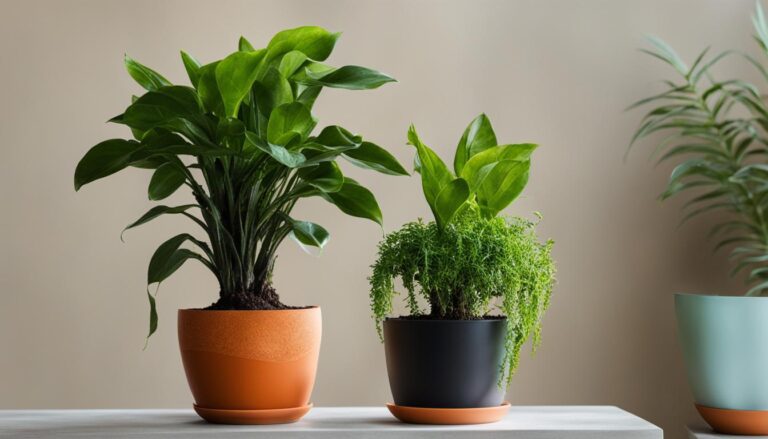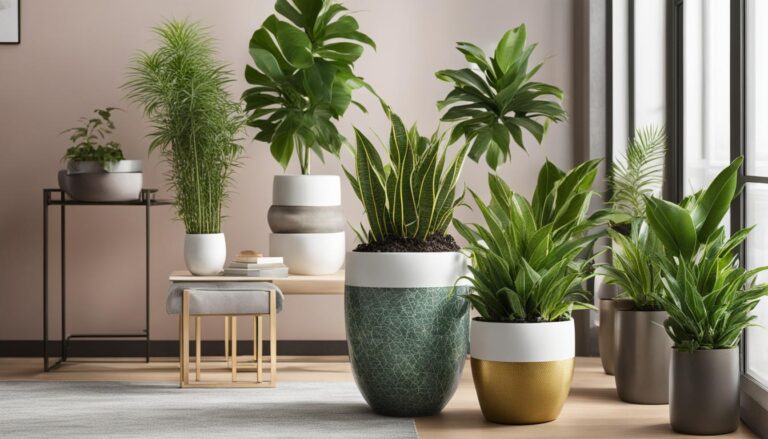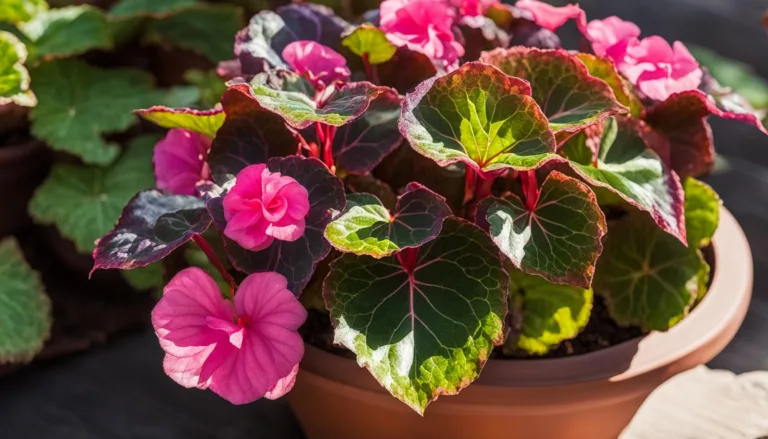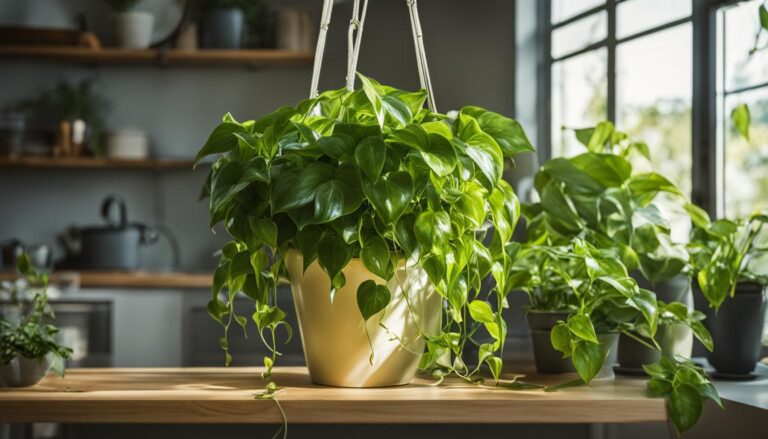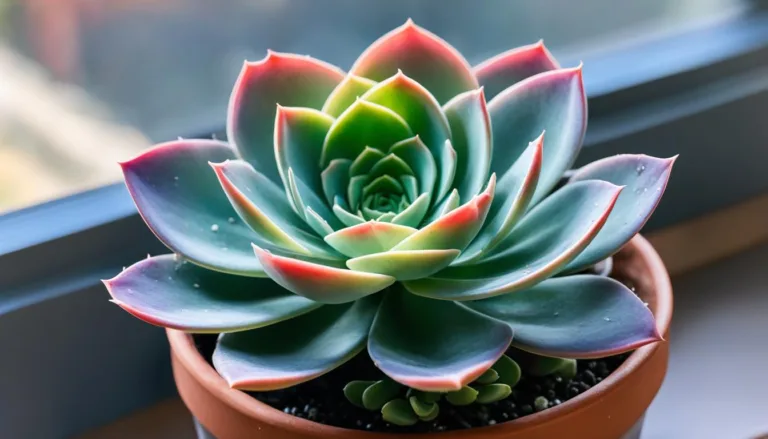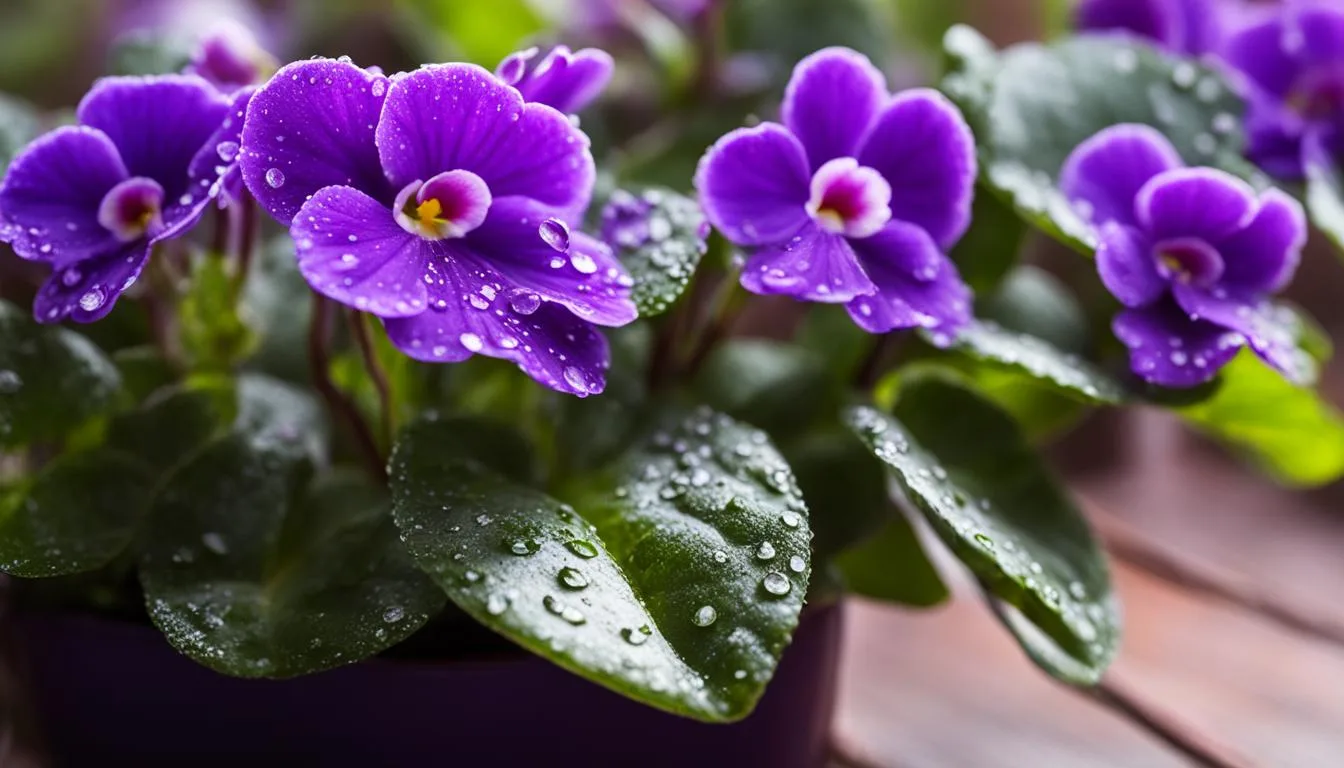
Hello, plant enthusiasts! If you’re looking to cultivate vibrant blooms and add a touch of color to your indoor space, African violets are an excellent choice. As a dedicated plant parent and lover of all things green, I’m excited to share my knowledge and experience on caring for African violets.
With the right care and attention, African violets can thrive and reward you with their stunning blossoms.
In this comprehensive care guide, I will walk you through essential tips and techniques to ensure your African violets bloom vibrantly. From providing adequate light to choosing the right potting mix, I’ve got you covered!
Now that you know what to expect from this article, let’s dive into the fascinating world of African violet care, and get ready to witness the vibrant blooms that will bring joy to your home!
Key Takeaways:
- Proper lighting is crucial for African violets to bloom, so place them near a window with bright, indirect light.
- Water your African violets once a week, ensuring the soil is slightly moist but not overly wet or dry.
- Maintain a humidity level of around 40-50% to create an ideal environment for blooming.
- Regularly fertilize your African violets with a mild fertilizer designed specifically for these plants.
- Choose the right potting mix and pot size to promote healthy root growth and maximize blooming potential.
Providing Adequate Light for African Violets
One of the key factors in ensuring vibrant blooms for African violets is providing them with adequate light. These plants thrive in bright, indirect light, making east-facing windows an ideal location. The morning sun that filters through these windows provides the perfect amount of light without the risk of scorching the delicate leaves.
If natural light is insufficient or not readily available, you can supplement with artificial lighting to meet their needs. Fluorescent lights positioned about 10-12 inches above the leaves can provide the necessary light intensity. Aim to keep the lights on for 10-12 hours a day to simulate natural daylight.
Remember that finding the right balance is crucial. While African violets require light to bloom, intense direct sunlight can cause their leaves to become sunburned or pale. On the other hand, insufficient light can result in weak, leggy growth and fewer blooms.
Benefits of Adequate Light for African Violets
- Promotes healthy leaf growth
- Encourages abundant blooming
- Enhances vibrant flower colors
- Prevents weak, leggy growth
| Light Requirement | Light Intensity | Light Duration |
|---|---|---|
| Bright, indirect light | 2000-3000 foot-candles | 10-12 hours a day |
| Supplemental artificial light | Fluorescent lights positioned 10-12 inches above leaves | 10-12 hours a day |
By providing adequate light, you can ensure that your African violets receive the energy they need to bloom vibrantly and produce an array of colorful flowers. Remember to strike a balance and monitor their response to light conditions to optimize their growth and blooming potential.
Proper Watering Techniques for African Violets
Watering is a crucial aspect of African violet care that directly affects their blooming success. These delicate plants prefer slightly moist conditions, with the soil never being bone dry or overly saturated. By following proper watering techniques, you can ensure your African violets stay healthy and vibrant.
One effective method of watering African violets is to thoroughly water the plant once a week. You can do this by either pouring water directly onto the soil from the top or by placing the pot in a shallow tray of water and allowing the plant to soak up the moisture from the bottom. Whichever method you choose, ensure that the excess water is promptly drained to prevent waterlogged roots.
In dry climates or during particularly hot periods, it may be necessary to supplement with additional water halfway through the week. This will help prevent the soil from drying out too much and maintain the desired slightly moist environment for your African violets.
Remember to avoid getting water on the leaves as this can lead to unsightly water spots and increase the risk of disease. Directing the water towards the soil will help keep the foliage clean and healthy.
Watering Tips for African Violets
| Watering Technique | Frequency | Notes |
|---|---|---|
| Top watering | Once a week | Pour water directly onto the soil from the top, allowing it to reach the roots. |
| Bottom watering | Once a week | Place the pot in a tray of water and allow the plant to absorb moisture from the bottom. |
| Supplemental watering | Halfway through the week (if needed) | In dry climates or during hot periods, provide additional water to prevent soil from drying out too much. |
| Avoid getting water on leaves | – | Direct water towards the soil to keep the foliage clean and prevent water spots. |
By following these watering techniques and providing your African violets with the right moisture levels, you’ll create the ideal conditions for vibrant blooms and healthy growth.
Maintaining Optimal Humidity for African Violets
African violets thrive in environments with a humidity level of around 40-50%. This moderate level of humidity helps promote healthy growth and vibrant blooming. However, dry air and drafts can negatively impact the budding and blooming process of these delicate plants.
To create a more humid environment for your African violets, you can employ a simple yet effective technique. Place your plants on trays filled with water and pebbles. The water will gradually evaporate, increasing the humidity around the plants.
Be careful not to let the pots sit directly in the water, as this can lead to root rot. Instead, position the pots on top of the pebbles, allowing them to capture the humidity without being submerged.
Another technique to maintain optimal humidity is to group your African violet plants together. When grouped closely, the plants create a microclimate where humidity is higher. This natural humidity pocket can benefit the plants and encourage healthy blooming.
Benefits of Optimal Humidity
- Facilitates proper water absorption and nutrient uptake
- Reduces the risk of leaf dehydration and browning
- Prevents flower buds from drying out and failing to open
- Creates a favorable environment for healthy root development
By maintaining the right humidity level for your African violets, you are providing them with the ideal conditions for vibrant blooms and overall plant health. Remember to monitor the humidity regularly, especially during winter when indoor air tends to be drier due to heating systems.
Fertilizing Techniques for African Violets
Proper fertilization is crucial for promoting healthy growth and vibrant blooming in African violets. These plants have specific nutritional needs that must be met to ensure their optimal health. In this section, I will provide you with essential tips and techniques for fertilizing your African violets effectively.
Choosing the Right Fertilizer
When selecting a fertilizer for your African violets, it’s important to choose a product specifically formulated for these plants. Look for a mild fertilizer with a balanced formula, such as 20-20-20 or one with slightly more phosphorus, like 15-20-15. These ratios provide the essential nutrients needed for healthy growth and abundant blooms.
Additionally, consider using a slow-release fertilizer that will gradually release nutrients over time. This can help ensure a steady supply of nutrients for your African violets without the need for frequent applications.
Applying the Fertilizer
Apply the fertilizer according to the instructions provided on the package. Dilute the recommended amount of fertilizer in water at the appropriate ratio. Avoid over-fertilizing, as this can lead to nutrient burn and other issues. It’s better to err on the side of caution and slightly under-fertilize than to risk damaging your plants.
When applying the fertilizer, water your African violets first to ensure the soil is moist. This will help prevent the roots from absorbing too much fertilizer at once. Pour the diluted fertilizer mixture evenly onto the soil, taking care to avoid getting any on the leaves, as this can cause burns or damage.
Fertilizing Schedule
Establishing a regular fertilizing schedule is essential for maintaining the health and blooming of your African violets. As a general guideline, fertilize your plants once a week during the active growing season, which typically lasts from spring to early fall. During the dormant period in winter, reduce the frequency to once every four to six weeks.
Keep in mind that the specific fertilizing needs of your African violets may vary based on factors such as the type of potting mix, lighting conditions, and overall plant health. Monitor your plants closely to determine if any adjustments to the fertilizing schedule are necessary.
| Fertilizer Type | NPK Ratio | Application Frequency |
|---|---|---|
| Mild Fertilizer | 20-20-20 | Once a week during active growth, once every 4-6 weeks during dormancy |
| Phosphorus-Rich Fertilizer | 15-20-15 | Once a week during active growth, once every 4-6 weeks during dormancy |
Potting Mix and Root Development for African Violets
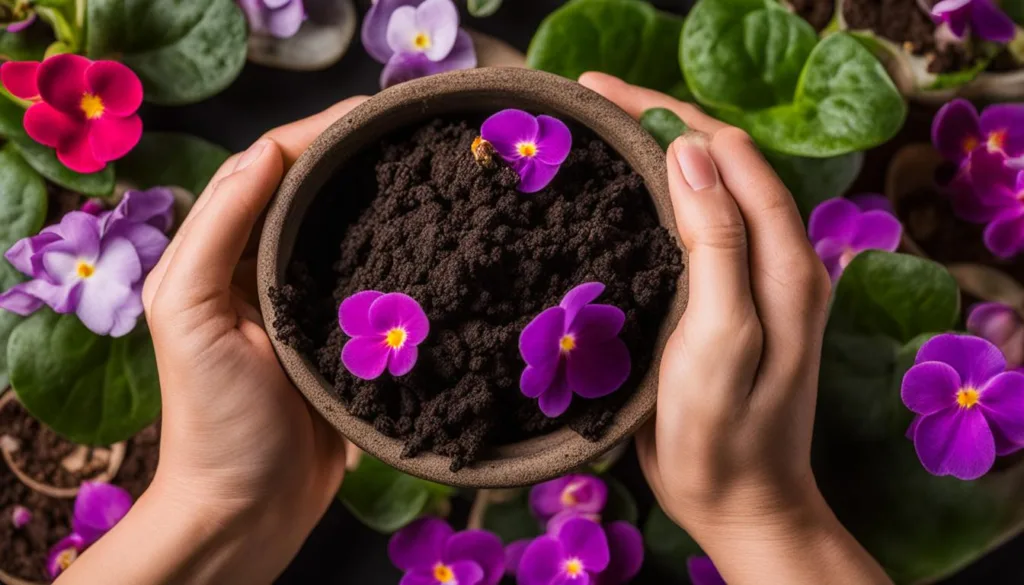
When it comes to African violet care, choosing the right potting mix is crucial for promoting healthy root development and vibrant blooms. The ideal potting mix should provide good drainage while retaining enough moisture for the plants to thrive.
One recommended recipe for a homemade mix is equal parts Canadian sphagnum peat moss, perlite, and vermiculite. This combination allows for proper aeration and prevents the soil from becoming too compact.
If you prefer using a commercial African violet mix, consider mixing it with perlite to ensure optimal porosity. This will help prevent waterlogging and allow roots to breathe. The goal is to create an environment where the roots can grow and spread easily, promoting overall plant health and blooming success.
When repotting your African violets, choose a pot that is slightly larger than the root ball to give the roots room to grow. Remember, African violets prefer to be slightly pot-bound, so avoid using excessively large containers. Additionally, ensure that the pot has drainage holes at the bottom to prevent water from pooling and potentially causing root rot.
Comparison of Potting Mixes for African Violets
| Potting Mix | Advantages | Disadvantages |
|---|---|---|
| Homemade Mix (peat moss, perlite, vermiculite) |
|
|
| Commercial Mix (mixed with perlite) |
|
|
Choosing the right potting mix and ensuring proper root development is essential for the overall health and blooming success of your African violets. By providing the ideal growing environment, you can enjoy vibrant and beautiful blooms.
Choosing the Right Pot for African Violets
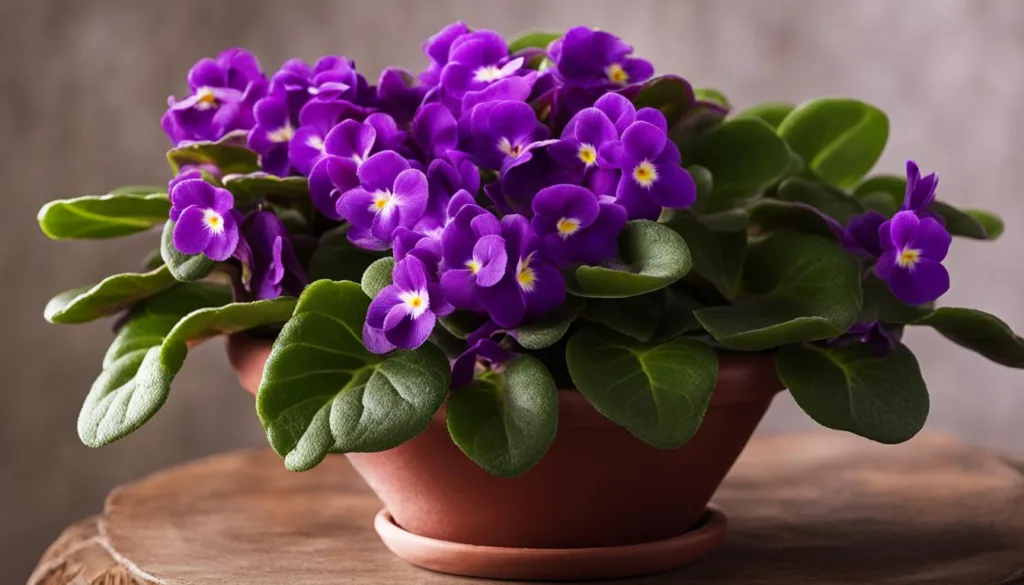
African violets thrive when grown in pots that are the perfect size for their needs. Choosing the right pot size is essential for promoting healthy growth and blooming. Here are some tips to help you select the ideal pot for your African violets:
1. Opt for a slightly smaller pot:
African violets prefer to be slightly pot-bound, meaning they like their roots to have a little bit of a snug fit. Choose a pot that is one-third the diameter of the plant to encourage root development and maximize blooming potential. Additionally, keep the pot depth to a maximum of two or three inches to prevent excessive moisture buildup.
2. Consider the material:
When it comes to pot materials, options such as plastic, ceramic, and clay are commonly used for African violets. Plastic pots retain moisture better, while clay pots offer better drainage. Ceramic pots can be a good middle ground. Consider your watering habits and the overall environment when deciding on the pot material.
3. Ensure proper drainage:
Regardless of the pot material, it’s crucial to have adequate drainage to prevent waterlogging. Look for pots with drainage holes at the bottom to allow excess water to escape. You can also use a layer of pebbles or broken pottery shards at the bottom of the pot to enhance drainage.
Remember, choosing the right pot size is just one aspect of African violet care. Combine it with proper lighting, watering, and other essential techniques to create the ideal environment for your African violets to thrive and bloom vibrantly.
Selecting Bloom-Prone African Violet Varieties
When it comes to African violets, not all varieties are created equal in terms of blooming frequency and abundance. If you want your African violets to consistently produce colorful and vibrant blooms, it’s essential to choose varieties that are known for their blooming prowess. Look for varieties that not only bloom frequently but also have blossom stems that carry multiple buds.
Opting for these bloom-prone African violet varieties will ensure a visually stunning display of blossoms throughout the year. Whether you’re a seasoned African violet enthusiast or a beginner looking to add some vibrant hues to your indoor garden, these varieties are sure to captivate your senses.
Popular Bloom-Prone African Violet Varieties
| Variety | Description |
|---|---|
| Rhapsodie in Blue | This variety features large, deep blue double blooms with ruffled petals. It blooms profusely throughout the year, adding a touch of elegance to any space. |
| Fantasy Greenery | With its variegated leaves and delicate, pale lavender blooms, Fantasy Greenery is a favorite among African violet enthusiasts. It consistently produces multiple blossoms, creating a delightful visual spectacle. |
| Sparkling Burgundy | As its name suggests, Sparkling Burgundy showcases stunning burgundy-colored blooms that pop against its dark green foliage. This variety is known for its abundant blooms and easy care requirements. |
| Rob’s Black Cherry | Rob’s Black Cherry is a stunning African violet variety that boasts deep burgundy flowers with a velvety texture. It is recognized for its prolific blooming habit and gorgeous coloration. |
These are just a few examples of the many bloom-prone African violet varieties available. Explore different varieties and find the ones that resonate with your style and preferences. With the right variety selection and proper care, your African violets will reward you with a continuous display of vibrant and exquisite blooms.
Expert Tips to Encourage African Violet Blooming
As an experienced African violet enthusiast, I’m excited to share some expert tips with you to help encourage vibrant blooms in your plants. In addition to the foundational care techniques mentioned earlier, there are a few extra tricks that can make all the difference.
Gently threatening your African violet, such as through light tapping on the pot or grooming off fading leaves and flowers, can actually stimulate flower development. It might sound strange, but trust me, it works! This mimics the natural conditions in their native habitat, where the plants are exposed to mild stressors that trigger blooming.
Another important factor is maintaining the correct temperature. African violets prefer temperatures between 65-75°F (18-24°C) during the day and slightly cooler at night. Extreme temperature fluctuations can disrupt blooming, so try to keep them in a consistent environment.
Additionally, be mindful of avoiding water on the leaves. African violets are susceptible to leaf spot diseases, and wet leaves create the perfect breeding ground. Instead, water directly at the base of the plant or use bottom watering methods to keep the foliage dry.
FAQ
How much light do African violets need to bloom?
African violets thrive in bright, indirect light, preferably near an east-facing window that receives morning sun.
How often should I water my African violets?
Water your African violets thoroughly once a week, ensuring the soil is slightly moist but not overly dry or soggy.
How can I increase humidity for my African violets?
To increase humidity, place the plants on trays filled with water and pebbles, making sure the pots don’t sit directly in the water.
What kind of fertilizer should I use for African violets?
Use a mild fertilizer designed for African violets once a week, following the instructions on the package for the appropriate dilution ratio.
What type of potting mix should I use for African violets?
Use a mix with good porosity, such as equal parts Canadian sphagnum peat moss, perlite, and vermiculite, or consider mixing a commercial African violet mix with perlite for better drainage.
How big should the pot be for African violets?
Choose pots that are one-third the diameter of the plant and no more than two or three inches deep to encourage root development and blooming.
What are some bloom-prone African violet varieties?
Look for varieties that not only bloom frequently but also have blossom stems that carry multiple buds for abundant and colorful blooms.
Are there any extra tips to encourage African violet blooming?
Lightly tapping the pot or grooming off fading leaves and flowers can stimulate flower development. Maintaining the correct temperature and avoiding water on the leaves can also help. Using specialized African violet potting soil is recommended for optimal growth.

